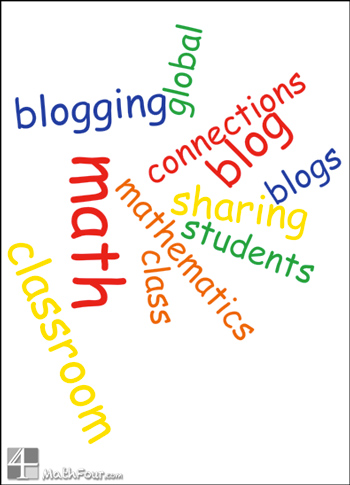 We had an interesting discussion last night on #mathchat about blogging in the classroom.
We had an interesting discussion last night on #mathchat about blogging in the classroom.
I’ve been knee deep in the blogosphere for years – including face to face groups and as a moderator in the Problogger.com forum. So I thought I’d share some insight into tackling online math sharing.
Things to Consider before You Take it On
Purpose – Why do you want the class to blog instead of just turn in reports?
Some reasons may be: permanence, global connections, promote pride in work, etc.
Platform – Where do you want your blog to live and why? Blogger, WordPress, Tumblr, Facebook…
Different platforms offer different levels of ease, customization, security, etc.
Cost – Are you willing to pay $15/month for it or do you want it totally free?
If you get it free, you might be held at the mercy of the platform. Facebook, for instance, has been known to change security settings on groups and even delete content.
If you want your content to last, you might opt for a paid version.
Advertisements – Will you put ads on the site? Are you okay with a free service loading ads on the site? Who gets the money if you monetize?
Security – Are your students young (i.e. not grownups)? Do you need permission slips? A password wall? What are the dangers and how will you keep your students safe?
Your skills – How tech savvy are you? Are you experienced in blogging? Do you need help?
What to Include
Students can post about a math project, personal math insights or math field trips. Each student should have a unique username and password so you can monitor who’s posting what.
Photos and videos are also nice additions to blogs – especially for a math blog. Just make sure students only post their own work – or confirm they have permission to post images from others.
Video based blogs are often called vlogs – but there’s really no difference. If you choose to upload things to YouTube.com, make sure this is clearly noted in the permission slips.
LaTeX (a special equation editor) is supported in WordPress. If your students are older and want to include nice equations in their posts, you might look into how to use the LaTeX features in the platform you choose.
Things to Teach (In Addition to the Math)
Blogging vocabulary – There’s some vernacular that’s good for baby bloggers to learn. This is my personal favorite:
A blog is a website on which blog posts are written. The blog itself contains the posts, all the formatting, advertisements, etc. Entries on a blog are called posts, blog posts or articles. Note: A person does not write a blog (that would mean the whole website). Instead a person writes a blog post.
Other blogging vocabulary can be found here.
Writing – Gather and share some age-appropriate guidelines on writing for an online audience. Writing online is very different than good old MLA.
If you know of a resource for this, please let me know. I am unable to find one quickly. And if you really need one, let me know. I’m happy to create it for us all.
Commenting – What are the rules? Who will moderate?
Students should be encouraged to comment on each other’s posts. But they should stay within some general guidelines.
Mostly this one: Write comments like teeny-tiny blog posts – short, sweet, easy to read and BE KIND.
If the children are young, you probably should be the comment moderator (after all, you could have all sorts of people around the world commenting). If they’re older, you might pick some more mature students to be on this task.
Sharing – Who is the audience and how will students get the word out to them?
Keeping up a blog is no fun if nobody knows about it. How will your students share the fact that they have a blog? Are they allowed to share on Facebook and Twitter? Will you encourage them to email their family members?
And if you want students to connect with others around the world, how will they do that?
Community – Part of blogging is commenting on other blogs.
How will your students find other similar blogs? Are they encouraged to comment on other blog posts directly? Or should they write a response post on their classroom blog?
Copyright and legal stuff – Keeping everyone honest.
Writing online is publishing. Which means all the legal stuff that comes with publishing, comes with blogging. Make sure students know (and adhere to) the rule of “no plagiarism.”
And explain that they can’t use images from the internet without permission – even if they give credit to the website where they came from!
It’s a lot – but you can do it!
If you have prior blogging experience, it’ll still be a challenge. Kids ask the darndest thing, y’know.
If you’re not a blogger, see if you can team with a blogger in your school or town – or even someone you’ve met online. It’ll be a great learning experience for you, too!
There are many benefits to blogging math. Are you ready to take it on?
Share your thoughts in the comments – or respond on your own blog and leave a link!
This post may contain affiliate links. When you use them, you support us so we can continue to provide free content!







Great advice, Bon.
May I add these resources to help your readers?
For copyright, Creative Commons, and authoring and media tools, check out my Creative Commons Resources.
For blogging help, why not take Teacher Challenge: 30 Days to Kick Start Your Blog or any of the other three Teacher Challenges?
For great examples of school-orientated student blogs and instructions on how to create and transport them, check out George Couros’ Beginners Guide to Creating a WordPress Portfolio (the good stuff is in Other Links) and my accompanying notes.
I hope your readers find these resources useful.
Shawn
Thanks so much Shawn – those look great!